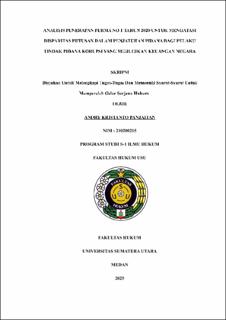| dc.description.abstract | The problem of corruption in Indonesia is still a serious threat that has not been
resolved, not only harming the country's finances but also having an impact on political
and social problems. One of the main factors that cause high rates of corruption is that
decisions often show significant disparities and often without strong consideration. In
response to this criticism, the Supreme Court of the Republic of Indonesia issued
Supreme Court Regulation (PERMA) Number 1 of 2020 concerning Criminal
Guidelines Article 2 and Article 3 of the Law on the Eradication of Corruption to
address the disparity in criminalization.
This research is a normative juridical research conducted by researching
through secondary data consisting of primary legal materials such as laws and
regulations and also using secondary legal materials such as legal literature related to
the formulation of problems in this study. To analyze this research, two approaches were
used, namely the statutory approach and the case approach. The data collection method
is carried out using a literature study procedure by conducting a review of written
information from various sources related to the implementation of PERMA No. 1 of
2020 in imposing penalties for perpetrators of corruption crimes that harm the state's
finances.
The results of the study show that PERMA No. 1 of 2020 is present as a flexible
criminal guideline where there is a criminal range as a reference. In its application,
judges must go through six stages, namely determining the category of state financial
losses, the level of error, impact, and profit, choosing the range of criminal imposition,
considering aggravating and mitigating circumstances, imposing a penalty, and
considering other provisions related to criminal imposition. Analysis of the rulings of
corruption cases shows that the application of PERMA can reduce the disparity of
verdicts, although there are still differences in the verdicts handed down, but still within
the range regulated by PERMA and accompanied by clear considerations. | en_US |


